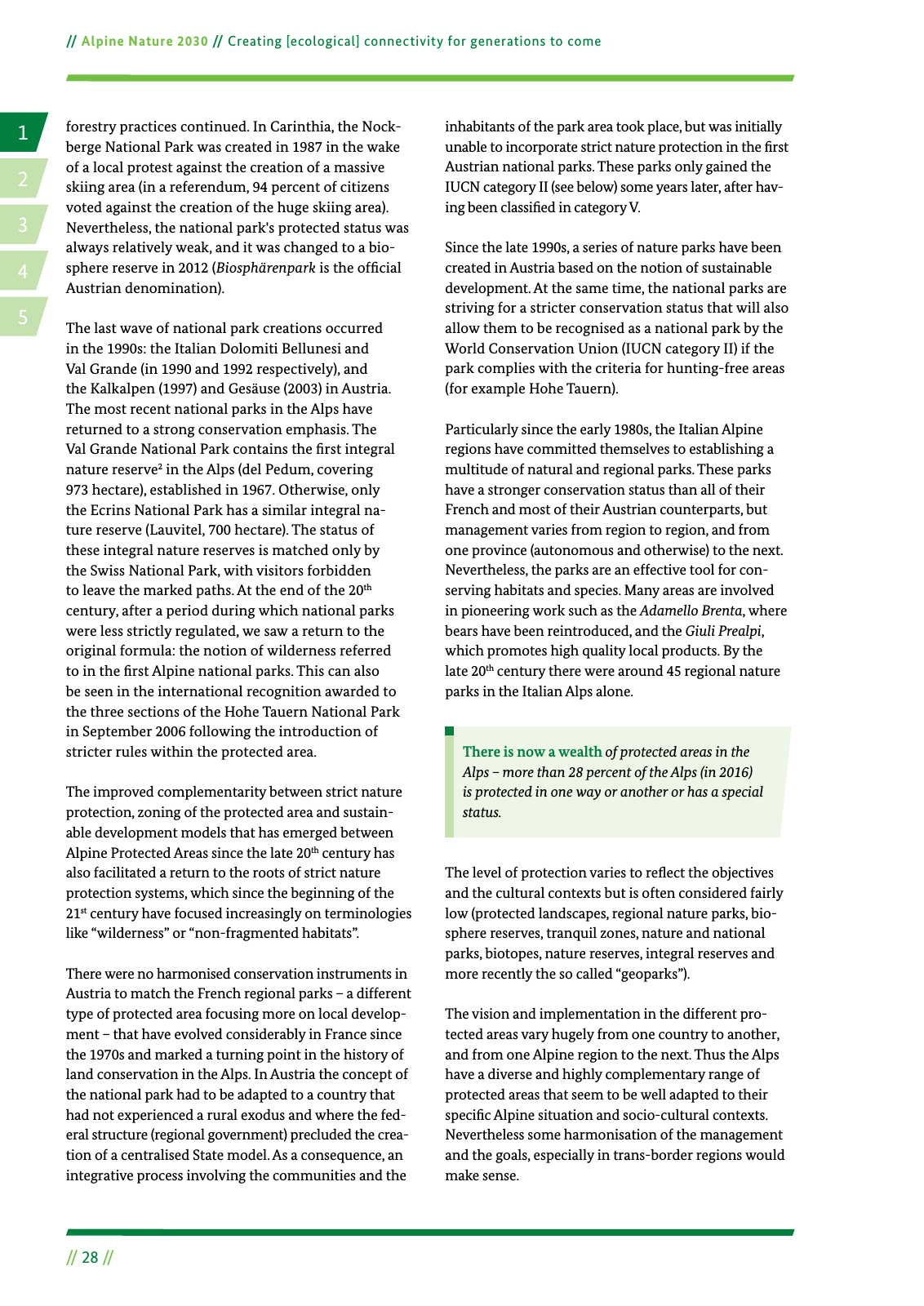14 2 5 3 28 Alpine Nature 2030 Creating ecological connectivity for generations to come forestry practices continued In Carinthia the Nock berge National Park was created in 1987 in the wake of a local protest against the creation of a massive skiing area in a referendum 94 percent of citizens voted against the creation of the huge skiing area Nevertheless the national park s protected status was always relatively weak and it was changed to a bio sphere reserve in 2012 Biosphärenpark is the of cial Austrian denomination The last wave of national park creations occurred in the 1990s the Italian Dolomiti Bellunesi and Val Grande in 1990 and 1992 respectively and the Kalkalpen 1997 and Gesäuse 2003 in Austria The most recent national parks in the Alps have returned to a strong conservation emphasis The Val Grande National Park contains the rst integral nature reserve2 in the Alps del Pedum covering 973 hectare established in 1967 Otherwise only the Ecrins National Park has a similar integral na ture reserve Lauvitel 700 hectare The status of these integral nature reserves is matched only by the Swiss National Park with visitors forbidden to leave the marked paths At the end of the 20th century after a period during which national parks were less strictly regulated we saw a return to the original formula the notion of wilderness referred to in the rst Alpine national parks This can also be seen in the international recognition awarded to the three sections of the Hohe Tauern National Park in September 2006 following the introduction of stricter rules within the protected area The improved complementarity between strict nature protection zoning of the protected area and sustain able development models that has emerged between Alpine Protected Areas since the late 20th century has also facilitated a return to the roots of strict nature protection systems which since the beginning of the 21st century have focused increasingly on terminologies like wilderness or non fragmented habitats There were no harmonised conservation instruments in Austria to match the French regional parks a different type of protected area focusing more on local develop ment that have evolved considerably in France since the 1970s and marked a turning point in the history of land conservation in the Alps In Austria the concept of the national park had to be adapted to a country that had not experienced a rural exodus and where the fed eral structure regional government precluded the crea tion of a centralised State model As a consequence an integrative process involving the communities and the inhabitants of the park area took place but was initially unable to incorporate strict nature protection in the rst Austrian national parks These parks only gained the IUCN category II see below some years later after hav ing been classi ed in category V Since the late 1990s a series of nature parks have been created in Austria based on the notion of sustainable development At the same time the national parks are striving for a stricter conservation status that will also allow them to be recognised as a national park by the World Conservation Union IUCN category II if the park complies with the criteria for hunting free areas for example Hohe Tauern Particularly since the early 1980s the Italian Alpine regions have committed themselves to establishing a multitude of natural and regional parks These parks have a stronger conservation status than all of their French and most of their Austrian counterparts but management varies from region to region and from one province autonomous and otherwise to the next Nevertheless the parks are an effective tool for con serving habitats and species Many areas are involved in pioneering work such as the Adamello Brenta where bears have been reintroduced and the Giuli Prealpi which promotes high quality local products By the late 20th century there were around 45 regional nature parks in the Italian Alps alone There is now a wealth of protected areas in the Alps more than 28 percent of the Alps in 2016 is protected in one way or another or has a special status The level of protection varies to re ect the objectives and the cultural contexts but is often considered fairly low protected landscapes regional nature parks bio sphere reserves tranquil zones nature and national parks biotopes nature reserves integral reserves and more recently the so called geoparks The vision and implementation in the different pro tected areas vary hugely from one country to another and from one Alpine region to the next Thus the Alps have a diverse and highly complementary range of protected areas that seem to be well adapted to their speci c Alpine situation and socio cultural contexts Nevertheless some harmonisation of the management and the goals especially in trans border regions would make sense

Hinweis: Dies ist eine maschinenlesbare No-Flash Ansicht.
Klicken Sie hier um zur Online-Version zu gelangen.
Klicken Sie hier um zur Online-Version zu gelangen.